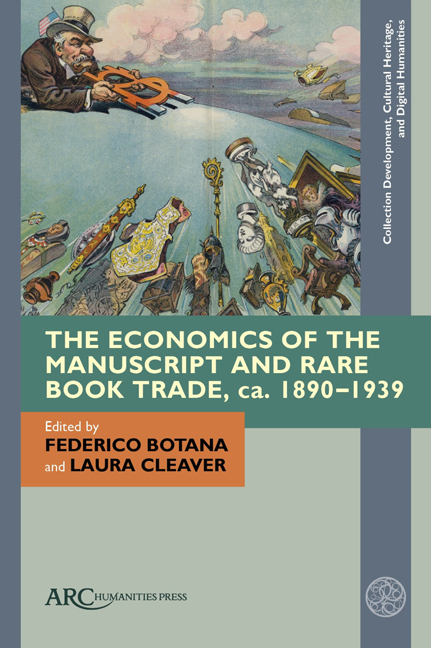Book contents
- Frontmatter
- Contents
- List of Illustrations
- List of Tables
- Acknowledgments
- Abbreviations
- Introduction. The Value of Rare Books
- Chapter 1 Valuing Rare Books in 1920s Germany: Prices in Jacques Rosenthal’s Bibliotheca medii aevi manuscripta
- Chapter 2 Leo S. Olschki’s Card Index and Potential Profits
- Chapter 3 Stock-books and Ledgers: J. & J. Leighton and Édouard Rahir and Company ca. 1897–1904 and E. P. Goldschmidt and Company ca. 1925–1933
- Chapter 4 Léopold Delisle, Henri Omont, and the Price of National Collecting: The Medieval Manuscript Acquisitions of the Bibliothèque nationale ca. 1900–1910
- Chapter 5 Herschel V. Jones: Public Collections and Private Investments
- Conclusion
- Appendix 1 Inflation
- Appendix 2 Exchange Rates
Chapter 3 - Stock-books and Ledgers: J. & J. Leighton and Édouard Rahir and Company ca. 1897–1904 and E. P. Goldschmidt and Company ca. 1925–1933
Published online by Cambridge University Press: 28 March 2024
- Frontmatter
- Contents
- List of Illustrations
- List of Tables
- Acknowledgments
- Abbreviations
- Introduction. The Value of Rare Books
- Chapter 1 Valuing Rare Books in 1920s Germany: Prices in Jacques Rosenthal’s Bibliotheca medii aevi manuscripta
- Chapter 2 Leo S. Olschki’s Card Index and Potential Profits
- Chapter 3 Stock-books and Ledgers: J. & J. Leighton and Édouard Rahir and Company ca. 1897–1904 and E. P. Goldschmidt and Company ca. 1925–1933
- Chapter 4 Léopold Delisle, Henri Omont, and the Price of National Collecting: The Medieval Manuscript Acquisitions of the Bibliothèque nationale ca. 1900–1910
- Chapter 5 Herschel V. Jones: Public Collections and Private Investments
- Conclusion
- Appendix 1 Inflation
- Appendix 2 Exchange Rates
Summary
IN ORDER TO sell books at a profit it is useful to have records of what items are in stock and the prices for which they were acquired. In the late nineteenth and early twentieth centuries booksellers tackled this task in slightly different ways, but most maintained stock-books in which they documented the value of items they had purchased and ledgers (or day books) listing the items sold. These would usually be part of larger sets of records, including lists of books sent to buyers “on approval,” which might be bought or returned to stock, and accounts of other financial transactions. Even once a book was sold, such records were valuable as information about the purchases of clients over many years and the prices that copies of the same book or similar books had achieved. In the rare books market no two copies, even of the same edition of a printed book, are identical, and factors such as condition, decoration, completeness, and binding can influence an item’s value. However, a dealer’s profits also relied on being able to match books with buyers who wanted them. Manuscripts are unique and therefore often easier to trace in business records. This case study will use the late nineteenth- and early twentieth-century stock-books and ledgers of two firms, J. & J. Leighton of London and Édouard Rahir and Company of Paris, to analyze the profits made on pre-modern manuscripts and examine how these correlate with the length of time items spent in the dealers’ stock, the sale price, and the identity of the buyer. The records suggest a highly efficient turn-over of material and the importance of relationships with clients as a factor in assessing how to price books. These findings provide a foundation for comparison with a later set of records, from the London-based firm E. P. Goldschmidt and Company. The latter cover the turbulent economic period of the depression, following the Wall Street Crash in 1929, providing insights into both consistency of dealer’s practices between firms and over time, and the impact of wider events at particular moments.
J. & J. Leighton
In London the firm of J. & J. Leighton, founded in 1798 and by the end of the nineteenth century run by the founder’s grandson Walter J. Leighton, maintained at least two sets of books with information about sales.
- Type
- Chapter
- Information
- Publisher: Amsterdam University PressPrint publication year: 2024



